brake KIA CEED 2016 Owners Manual
[x] Cancel search | Manufacturer: KIA, Model Year: 2016, Model line: CEED, Model: KIA CEED 2016Pages: 643, PDF Size: 38.19 MB
Page 8 of 643
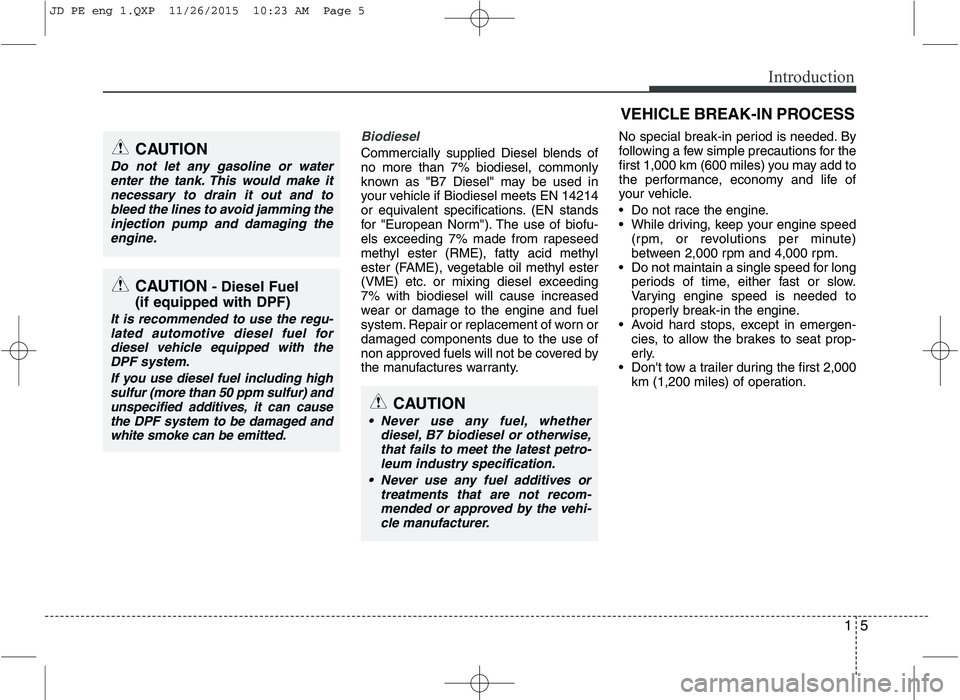
15
Introduction
Biodiesel
Commercially supplied Diesel blends of no more than 7% biodiesel, commonly
known as "B7 Diesel" may be used in
your vehicle if Biodiesel meets EN 14214
or equivalent specifications. (EN stands
for "European Norm"). The use of biofu-
els exceeding 7% made from rapeseed
methyl ester (RME), fatty acid methyl
ester (FAME), vegetable oil methyl ester
(VME) etc. or mixing diesel exceeding7% with biodiesel will cause increased
wear or damage to the engine and fuel
system. Repair or replacement of worn ordamaged components due to the use of
non approved fuels will not be covered by
the manufactures warranty.No special break-in period is needed. By
following a few simple precautions for the
first 1,000 km (600 miles) you may add to
the performance, economy and life of
your vehicle.
Do not race the engine.
While driving, keep your engine speed
(rpm, or revolutions per minute)
between 2,000 rpm and 4,000 rpm.
Do not maintain a single speed for long
periods of time, either fast or slow.
Varying engine speed is needed to
properly break-in the engine.
Avoid hard stops, except in emergen-
cies, to allow the brakes to seat prop-
erly.
Don't tow a trailer during the first 2,000 km (1,200 miles) of operation.CAUTION
Do not let any gasoline or water
enter the tank. This would make itnecessary to drain it out and to bleed the lines to avoid jamming the
injection pump and damaging theengine.
CAUTION - Diesel Fuel
(if equipped with DPF)
It is recommended to use the regu- lated automotive diesel fuel for
diesel vehicle equipped with theDPF system.
If you use diesel fuel including highsulfur (more than 50 ppm sulfur) andunspecified additives, it can cause
the DPF system to be damaged andwhite smoke can be emitted.
CAUTION
Never use any fuel, whether diesel, B7 biodiesel or otherwise,
that fails to meet the latest petro-leum industry specification.
Never use any fuel additives or treatments that are not recom-mended or approved by the vehi-
cle manufacturer.
VEHICLE BREAK-IN PROCESS
JD PE eng 1.QXP 11/26/2015 10:23 AM Page 5
Page 14 of 643

Your vehicle at a glance
6
2
ENGINE COMPARTMENT
OJD072001/OJD072002
❈
The actual engine room in the vehicle may differ from the illustration. 1. Engine oil filler cap ............................7-28
2. Brake/clutch fluid reservoir ................7-32
3. Positive battery terminal ....................7-42
4. Negative battery terminal ..................7-42
5. Fuse box ............................................7-56
6. Air cleaner ........................................7-35
7. Radiator cap ......................................7-31
8. Engine coolant reservoir....................7-29
9. Engine oil dipstick..............................7-27
10. Windshield washer fluid reservoir ....7-33
■■
Gasoline engine (GDI)
■■Gasoline engine (MPI)
JD PE eng 2.QXP 9/9/2015 4:10 PM Page 6
Page 15 of 643

27
Your vehicle at a glance
1. Engine oil filler cap ............................7-28
2. Brake/clutch fluid reservoir ................7-32
3. Positive battery terminal ....................7-42
4. Negative battery terminal ..................7-42
5. Fuse box ............................................7-56
6. Air cleaner ........................................7-35
7. Radiator cap ......................................7-31
8. Engine coolant reservoir....................7-29
9. Engine oil dipstick..............................7-27
10. Windshield washer fluid reservoir ....7-33
OJD075106L❈The actual engine room in the vehicle may differ from the illustration.
■
■
Gasoline engine (Gamma 1.6 T-GDI)
JD PE eng 2.QXP 9/9/2015 4:10 PM Page 7
Page 16 of 643

Your vehicle at a glance
8
2
OGD075001/OJD075100L
❈
The actual engine room in the vehicle may differ from the illustration. 1. Engine oil filler cap ............................7-28
2. Brake/clutch fluid reservoir ................7-32
3. Positive battery terminal ....................7-42
4. Negative battery terminal ..................7-42
5. Fuse box ............................................7-56
6. Air cleaner ........................................7-35
7. Radiator cap ......................................7-31
8. Engine coolant reservoir....................7-29
9. Engine oil dipstick..............................7-27
10. Windshield washer fluid reservoir ....7-33
■■
Gasoline Engine (Kappa 1.4 MPI)
■■Gasoline Engine (Kappa 1.0 T-GDI)
JD PE eng 2.QXP 9/9/2015 4:10 PM Page 8
Page 17 of 643

29
Your vehicle at a glance
OJD075101L
❈
The actual engine room in the vehicle may differ from the illustration.
1. Engine oil filler cap ............................7-28
2. Brake/clutch fluid reservoir ................7-32
3. Positive battery terminal ....................7-42
4. Negative battery terminal ..................7-42
5. Fuse box ............................................7-56
6. Air cleaner ........................................7-35
7. Radiator cap ......................................7-31
8. Engine coolant reservoir....................7-29
9. Engine oil dipstick..............................7-27
10. Windshield washer fluid reservoir ....7-33
11. Fuel filter ........................................7-34
■■
Diesel engine (UII)
JD PE eng 2.QXP 9/9/2015 4:11 PM Page 9
Page 36 of 643
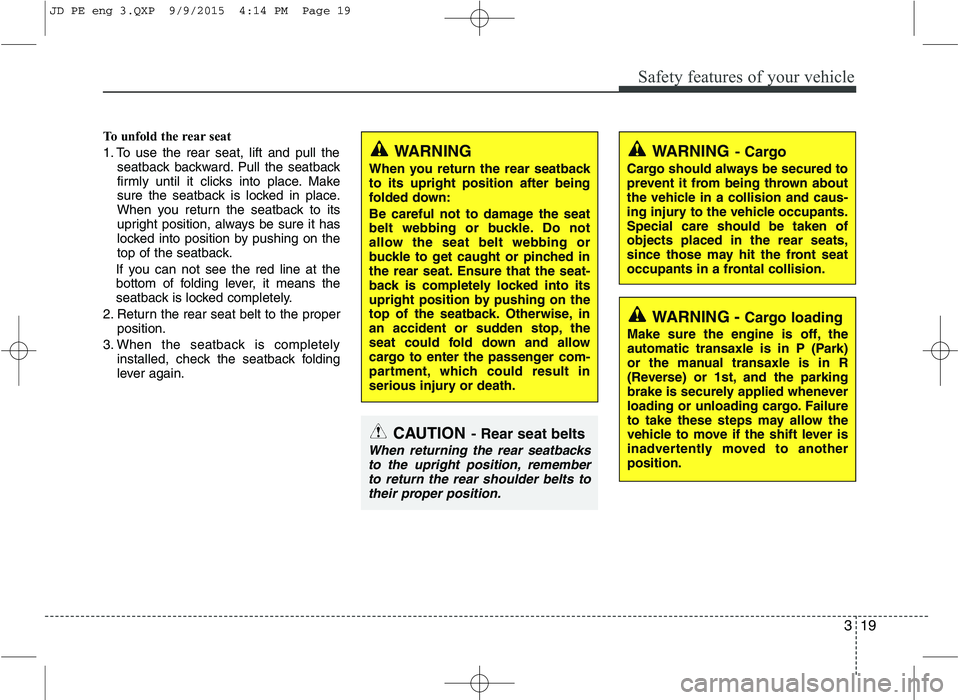
319
Safety features of your vehicle
To unfold the rear seat
1. To use the rear seat, lift and pull theseatback backward. Pull the seatback
firmly until it clicks into place. Make
sure the seatback is locked in place.
When you return the seatback to its
upright position, always be sure it has
locked into position by pushing on the
top of the seatback.
If you can not see the red line at the
bottom of folding lever, it means the
seatback is locked completely.
2. Return the rear seat belt to the proper position.
3. When the seatback is completely installed, check the seatback folding
lever again.
WARNING
When you return the rear seatback to its upright position after being
folded down:
Be careful not to damage the seat
belt webbing or buckle. Do not
allow the seat belt webbing or
buckle to get caught or pinched in
the rear seat. Ensure that the seat-
back is completely locked into its
upright position by pushing on the
top of the seatback. Otherwise, in
an accident or sudden stop, the
seat could fold down and allow
cargo to enter the passenger com-
partment, which could result in
serious injury or death.
CAUTION - Rear seat belts
When returning the rear seatbacks
to the upright position, remember to return the rear shoulder belts totheir proper position.
WARNING - Cargo
Cargo should always be secured to
prevent it from being thrown about
the vehicle in a collision and caus-
ing injury to the vehicle occupants.Special care should be taken ofobjects placed in the rear seats,
since those may hit the front seat
occupants in a frontal collision.
WARNING - Cargo loading
Make sure the engine is off, the
automatic transaxle is in P (Park)
or the manual transaxle is in R
(Reverse) or 1st, and the parking
brake is securely applied whenever
loading or unloading cargo. Failure
to take these steps may allow the
vehicle to move if the shift lever is
inadvertently moved to anotherposition.
JD PE eng 3.QXP 9/9/2015 4:14 PM Page 19
Page 80 of 643
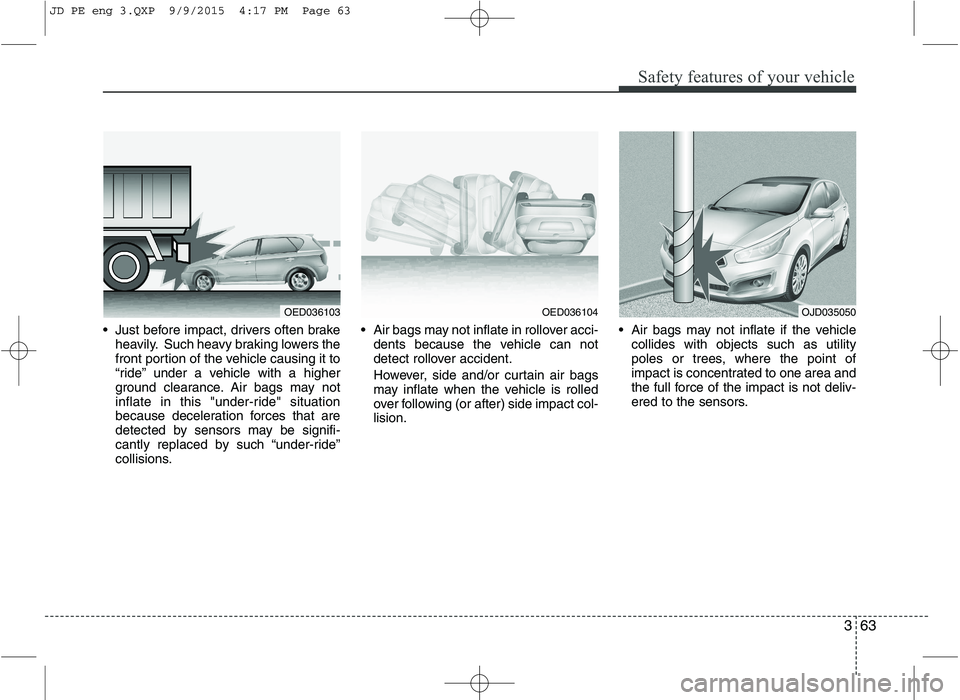
363
Safety features of your vehicle
Just before impact, drivers often brakeheavily. Such heavy braking lowers the
front portion of the vehicle causing it to
“ride” under a vehicle with a higher
ground clearance. Air bags may not
inflate in this "under-ride" situation
because deceleration forces that are
detected by sensors may be signifi-
cantly replaced by such “under-ride”
collisions. Air bags may not inflate in rollover acci-
dents because the vehicle can not
detect rollover accident.
However, side and/or curtain air bags
may inflate when the vehicle is rolled
over following (or after) side impact col-lision. Air bags may not inflate if the vehicle
collides with objects such as utility
poles or trees, where the point of
impact is concentrated to one area and
the full force of the impact is not deliv-
ered to the sensors.
OED036103OED036104OJD035050
JD PE eng 3.QXP 9/9/2015 4:17 PM Page 63
Page 103 of 643
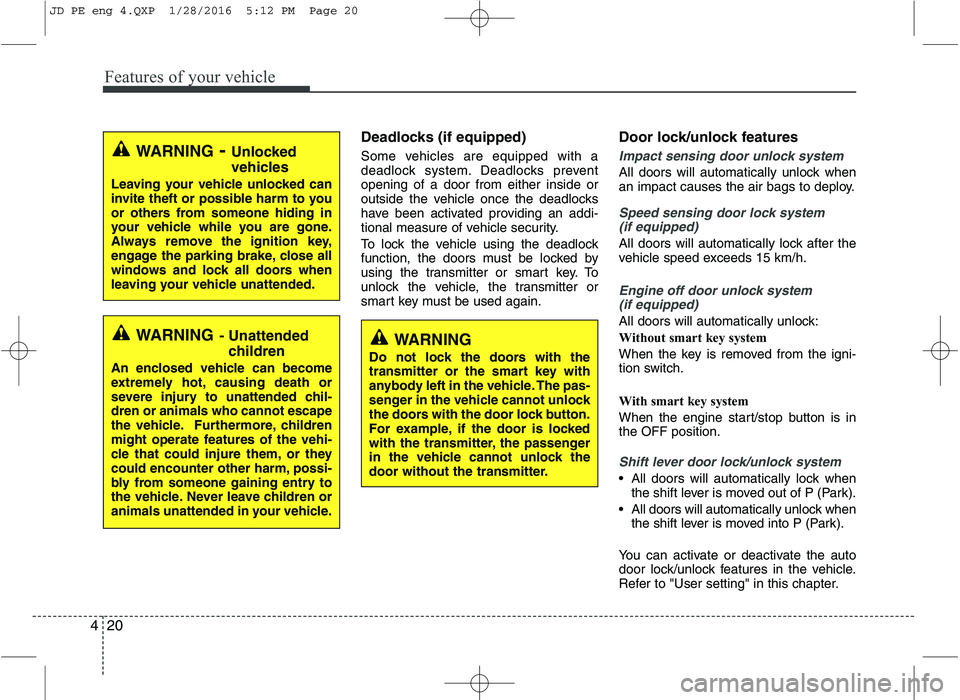
Features of your vehicle
20
4
Deadlocks (if equipped)
Some vehicles are equipped with a
deadlock system. Deadlocks preventopening of a door from either inside or
outside the vehicle once the deadlocks
have been activated providing an addi-
tional measure of vehicle security.
To lock the vehicle using the deadlock
function, the doors must be locked by
using the transmitter or smart key. To
unlock the vehicle, the transmitter or
smart key must be used again. Door lock/unlock features
Impact sensing door unlock system
All doors will automatically unlock when
an impact causes the air bags to deploy.
Speed sensing door lock system
(if equipped)
All doors will automatically lock after the
vehicle speed exceeds 15 km/h.
Engine off door unlock system (if equipped)
All doors will automatically unlock:
Without smart key system
When the key is removed from the igni-
tion switch.
With smart key system
When the engine start/stop button is in the OFF position.
Shift lever door lock/unlock system
All doors will automatically lock when the shift lever is moved out of P (Park).
All doors will automatically unlock when the shift lever is moved into P (Park).
You can activate or deactivate the auto
door lock/unlock features in the vehicle.
Refer to "User setting" in this chapter.
WARNING
Do not lock the doors with the
transmitter or the smart key with
anybody left in the vehicle. The pas-
senger in the vehicle cannot unlock
the doors with the door lock button.
For example, if the door is locked
with the transmitter, the passenger
in the vehicle cannot unlock the
door without the transmitter.
WARNING - Unlocked
vehicles
Leaving your vehicle unlocked can
invite theft or possible harm to you
or others from someone hiding in
your vehicle while you are gone.
Always remove the ignition key,
engage the parking brake, close all
windows and lock all doors when
leaving your vehicle unattended.
WARNING - Unattended
children
An enclosed vehicle can become
extremely hot, causing death or
severe injury to unattended chil-dren or animals who cannot escape
the vehicle. Furthermore, children
might operate features of the vehi-
cle that could injure them, or they
could encounter other harm, possi-
bly from someone gaining entry to
the vehicle. Never leave children or
animals unattended in your vehicle.
JD PE eng 4.QXP 1/28/2016 5:12 PM Page 20
Page 111 of 643
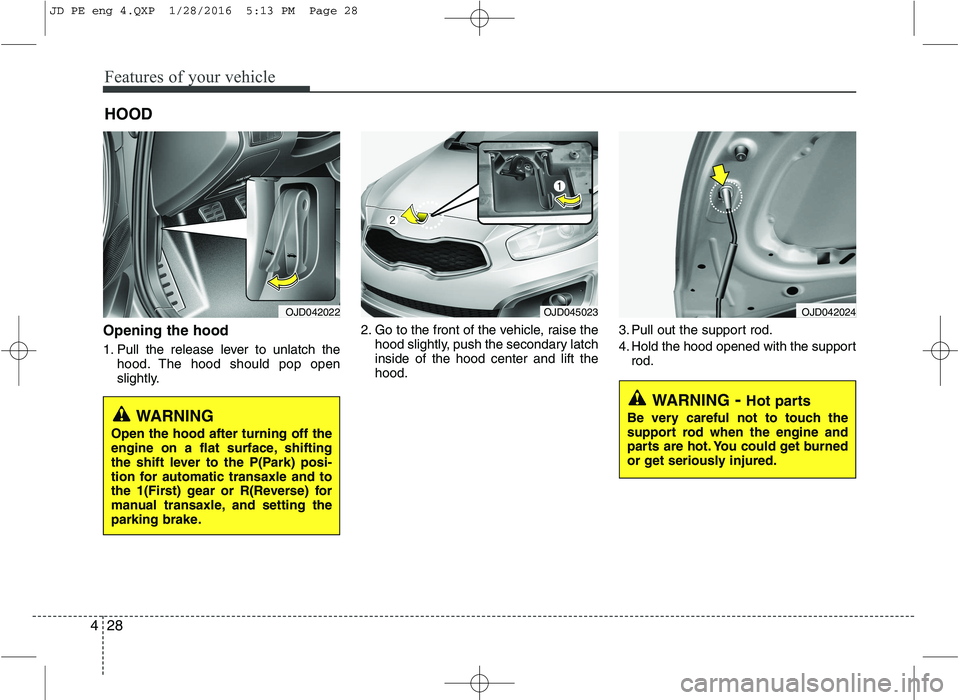
Features of your vehicle
28
4
Opening the hood
1. Pull the release lever to unlatch the
hood. The hood should pop open
slightly. 2. Go to the front of the vehicle, raise the
hood slightly, push the secondary latchinside of the hood center and lift thehood. 3. Pull out the support rod.
4. Hold the hood opened with the support
rod.
HOOD
OJD042022
WARNING
Open the hood after turning off the
engine on a flat surface, shifting
the shift lever to the P(Park) posi-
tion for automatic transaxle and to
the 1(First) gear or R(Reverse) for
manual transaxle, and setting the
parking brake.
WARNING - Hot parts
Be very careful not to touch the
support rod when the engine and
parts are hot. You could get burned
or get seriously injured.
OJD045023OJD042024
JD PE eng 4.QXP 1/28/2016 5:13 PM Page 28
Page 133 of 643
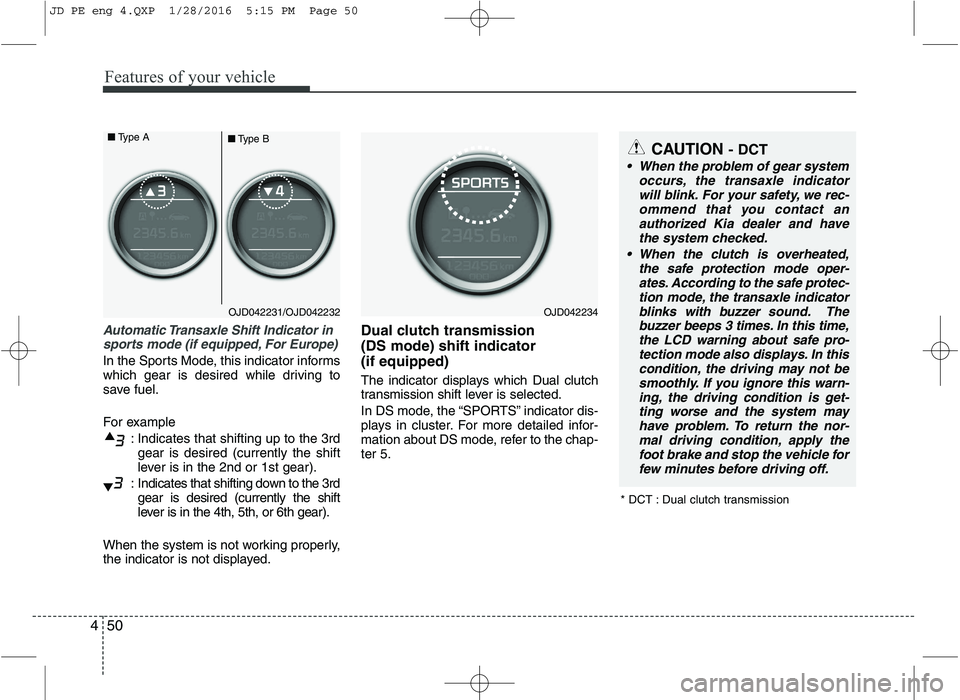
Features of your vehicle
50
4
Automatic Transaxle Shift Indicator in
sports mode (if equipped, For Europe)
In the Sports Mode, this indicator informs
which gear is desired while driving to
save fuel.
For example
: Indicates that shifting up to the 3rdgear is desired (currently the shift
lever is in the 2nd or 1st gear).
: Indicates that shifting down to the 3rd gear is desired (currently the shift
lever is in the 4th, 5th, or 6th gear).
When the system is not working properly,
the indicator is not displayed. Dual clutch transmission (DS mode) shift indicator (if equipped)
The indicator displays which Dual clutch
transmission shift lever is selected.
In DS mode, the “SPORTS” indicator dis-
plays in cluster. For more detailed infor-
mation about DS mode, refer to the chap-ter 5.
OJD042234OJD042231/OJD042232
■
Type A
■Type B
* DCT : Dual clutch transmission
CAUTION - DCT
When the problem of gear system
occurs, the transaxle indicatorwill blink. For your safety, we rec-ommend that you contact an
authorized Kia dealer and havethe system checked.
When the clutch is overheated, the safe protection mode oper-ates. According to the safe protec-
tion mode, the transaxle indicator blinks with buzzer sound. The buzzer beeps 3 times. In this time,the LCD warning about safe pro-
tection mode also displays. In this condition, the driving may not besmoothly. If you ignore this warn- ing, the driving condition is get-
ting worse and the system may have problem. To return the nor-mal driving condition, apply the foot brake and stop the vehicle for
few minutes before driving off.
JD PE eng 4.QXP 1/28/2016 5:15 PM Page 50